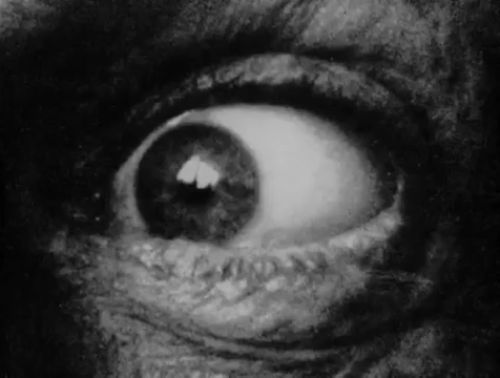
‘Arthur Lipsett is cinema’s lost prophet. Outside of Canada, his unique legacy of work has long been forgotten. But the Montreal-born filmmaker’s masterpiece, 21-87 (1964), inspired an idea that is probably worth the GDP of a small country these days. “When George saw 21-87, a light bulb went off,” says George Lucas collaborator Walter Murch. That spark formed Lucas’s ideas for “the force” and the rest is Star Wars history. Lucas himself acknowledged the influence in a hidden code Lipsett might have appreciated – Princess Leia’s cell number on the Death Star was 2187, while the action in his dystopian sci-fi THX 1138 (1971) took place in the year 2187.
‘Growing up in suburban Montreal in the 40s, the son of Russian Jewish parents, Lipsett’s childhood was traumatic. As a young boy, he had watched his mother walk out into the snow and drink rat poison, dying days later. By the mid-50s, Lipsett was studying art at Montreal’s Musée des beaux-arts, under the wing of expressionist painter Arthur Lismer, a member of the influential “Group of Seven” art movement. On graduating, a recommendation from his mentor led to work as an editor at the National Film Board, based in Montreal’s Ville St-Laurent.
‘As the evening crept in and his co-workers began to leave, he would embark on bizarre experiments until dawn – chain-smoking and raiding the garbage, he would dig out scraps of sound and visuals, and recycle them into collages that used the cinema screen as their canvas. In 1961, the results of Lipsett’s frenzied late-night scavenging surfaced in the short film Very Nice, Very Nice (1961). In the film, Lipsett turned apparently ordinary stock images into a horror story of modern life. As washing machines, Bakelite TVs and Ford Thunderbirds rolled off conveyor belts into suburban homes, and American and Soviet relations cooled into nuclear dread, Lipsett distilled the Cold War climate into six minutes of controlled hysteria. Like some finely-tuned antenna, it portrayed Lipsett’s perception of the universe in all its absurdity, laced, as it was, with pitch-black humour. Influenced by the Beats and the cut-up technique that William Burroughs pioneered, his images of cityscapes, crowds, circus acts and hydrogen bombs jostled for space alongside a soundtrack of random conversation, heavy breathing, chanting and car horns.
‘While some critics found Lipsett’s machine-gunned images baffling, the younger generation felt he was talking their language. So did Stanley Kubrick, who sent him a letter describing Very Nice, Very Nice (1961) as “one of the most imaginative and brilliant uses of the movie screen and soundtrack that I have ever seen”. It’s rumoured that Kubrick even asked Lipsett to create the trailer for his cold-war satire Dr Strangelove (1964) and was turned down by the 25-year-old. Pablo Ferro stepped in with the now famous opening, featuring a couple of B-52s in a mile-high metallic love scene. Meanwhile, Lipsett was nominated for an Oscar in 1962, and he became something of an outsider celebrity in Montreal’s avant-garde circles. He was operating in the right place. The city may be hyped these days for its music scene (Arcade Fire’s Win Butler claims it took just two days to put a band together on arriving), but Montreal’s film scene has long been a hot-bed of homegrown talent. In keeping with its liberal attitude, the Film Board gave Lipsett free reign to conjure up his next creation, 21-87 (1964). This time, the filmmaker used his own footage as well, captured around Montreal on his Stellavox Candid Tape Recorder. For the soundtrack, field recordings, gospel music, church hymns and conversation were instinctively cut together like some wired jazz improvisation. Opening on a skull, cutting to a woman suspended from a trapeze, a corpse being sawn in half, funhouse mirrors, circus elephants and monkey astronauts, it was Lipsett’s breathtaking indictment of mass-consumerism. The film wasn’t just a portal into Lipsett’s own brain – he had plugged into, as he put it, “the collective consciousness and unconsciousness of a civilisation”. Featuring conversations with Warren S McCulloch, pioneer of artificial intelligence, and Roman Kroitor, a director who helped develop IMAX, he questioned what it is to be human in the age of technology.
‘Montreal filmmaker Eric Gaucher, who recently completed a beautifully shot documentary on Lipsett, describes him as an accidental filmmaker. “He always approached film from an artist’s perspective. He challenged mathematicians to re-edit and re-structure his films just to see what could happen,” he explains. “He was very liberal in that sense.”
‘Lipsett followed up with Free Fall (1964), inspired by a Dylan Thomas poem and intended as a collaboration with avant-garde composer John Cage, employing his use of “chance music”. With its rapidly edited flashes of disconnected faces on city streets and sunlight streaming through trees, Lipsett talked about his film as an attempt to “hold time together” and described his intentions in typically apocalyptic language – “An attempt to express in filmic terms an intensive flow of life – a vision of a world in the throes of creativity… a visual bubbling of picture and sound operating to create a new continuity of experience… it is as if all clocks ceased to tick – summoned by a big close-up or fragment of a diffuse nature – strange shapes shine forth from the abyss of timelessness.”
‘Next came the time-capsule A Trip Down Memory Lane (1965), followed by Fluxes (1969) and N-Zone (1970), each film becoming progressively darker. Fluxes (1969) featured newsreel footage of the architect of the Final Solution, Adolf Eichmann, recorded over a soundtrack of 50s science-fiction dialogue. By the time Lipsett completed N-Zone (1970), with its repeated chant “In ten years, Margery has not slept once” playing over pictures of dead animals and injured dogs, the NFB was beginning to find his vision of life impossibly bleak. At the same time, Lipsett’s mental health was rapidly deteriorating. He resigned from the Film Board in 1978, and began to grow increasingly paranoid with the onset of chronic schizophrenia.
‘After his move to a house overlooking an enormous cemetery, Lipsett’s life story grows hazy. He found himself in and out of hospitals and on and off medication. He briefly returned to cinema once, with an idea for a film on “the occupation of corners”, but it never materialised. After a series of failed attempts at suicide (what he called his “little experiments”), he took his own life in 1986, just before his 50th birthday.
‘Over two decades later, his films remain available only at the expansive National Film Board archive. While the likes of experimental filmmakers Bruce Conner or Maya Deren find ever-expanding audiences, Lipsett has fallen through the cracks. Gaucher’s vital documentary (some of which was shot with Lipsett’s own Bolex) is only the second attempt to analyse his life on film. Record company Honest Jon’s valued Lipsett’s soundtracks highly enough to release a limited-edition compilation on vinyl, but outside of a small filmmaking community, the man once described as the William Blake of cinema remains an enigmatic figure. “His films generate a severe emotional reaction to humanity,” says Gaucher. “That’s what I get out of most people who watch them.” For all his contemplation of spiritual disillusionment, Lipsett found the human warmth in what he described as “the super-machine age” and it still resonates today.’ — Hannah Lack, Dazed Digital
____
Stills



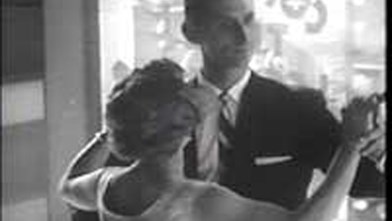

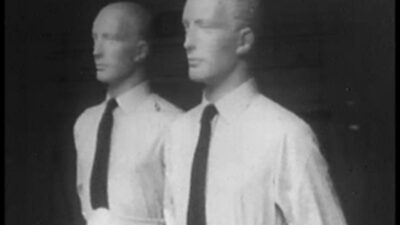


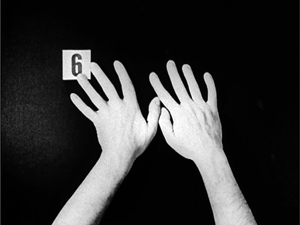
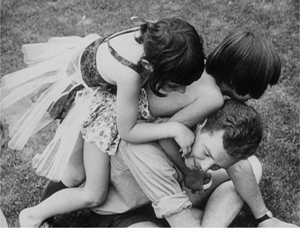




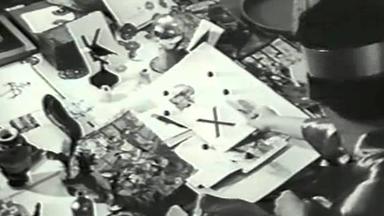


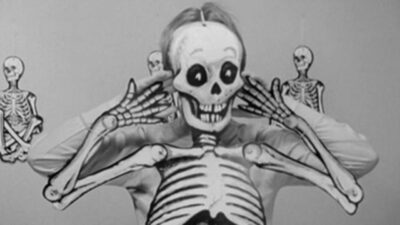








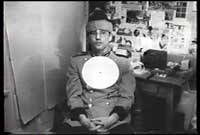


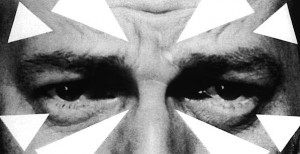
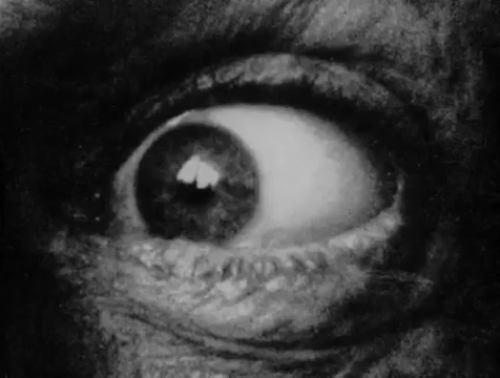










_____
Further
Arthur Lipsett Great Director profile • Senses of Cinema
Arthur Lipsett @ NFB
Arthur Lipsett @ IMDb
The Spiritual Disenchantment of the Super Machine Age
A Clown Outside the Circus
Reflections From the Social Dystopia: Films by Arthur Lipsett
The End
HOW ARTHUR LIPSETT INFLUENCED GEORGE LUCAS’S CAREER
Arthur Lipsett @ Light Cone
ARTHUR LIPSETT, SOUNDTRACKS
Making meaning with images: tools, resources and inspiration for visual communication
The Subtle Reference in The Force Awakens to the Art Film That Inspired Star Wars
Do Not Look Away: The Life of Arthur Lipsett
Transcending the Documentary: The Films of Arthur Lipsett
On Arthur Lipsett
Experimental Film Through the Eyes of Arthur Lipsett
From Compilation to Collage: The Found-Footage Films of Arthur Lipsett
Remembering Arthur Lipsett: The Collage Makes the Man
The Arthur Lipsett Project: A Dot on the Histomap.
______________
The Arthur Lipsett Project: A Dot on the Histomap
‘This full-length documentary introduces us to Arthur Lipsett, a man who defined experimental filmmaking at the NFB in the 1960s. His second film, Very Nice, Very Nice, was nominated for an Academy Award. George Lucas claimed him as an important influence. A decade later, Lipsett’s last attempt at filmmaking ended in failure. He chained his Steenbeck and film racks to prevent theft and vanished into paranoia.’ — nfb.ca

____
Extras
Trailer for “Remembering Arthur”, a documentary film

Teenagers discuss experimental Arthur Lipsett films they have just watched
(watch it here)
Les Journaux de Lipsett
________________
Bruce Conner interviewed about Arthur Lipsett
from INCITE!
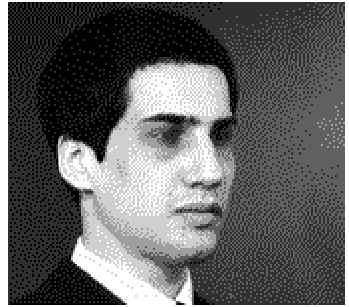
Amelia Does: I was wondering if you could talk about Arthur Lipsett and compare some of the films. Do you remember seeing Very Nice, Very Nice (1961)?
Bruce Conner: Yes, I remember seeing Very Nice, Very Nice, and some of Lipsett’s films in 1964-65 in Montreal. I met him only briefly–for no more than about ten minutes–and I thought he was a rather intense person and very much in a critical frame of mind. He seemed to have bitterness as well at times. But otherwise he seemed a nice person to me.
AD: Did he tell you that he had seen your works?
BC: I’m sure he had seen my films. He was headed in the same sort of direction that I was. Looking over his films in general, I see a number of things that could be derivative from my films. A Movie and Cosmic Ray, which I completed in 1961, were totally unique films and nobody had made anything quite like them before. So when I saw more films like mine following that period, that use some of the same techniques, I could recognize the films as being like my films.
Many times I felt it difficult to recognize if somebody might be making films like mine, whereas another person might think so. But there were certain technical aspects in the way the films were made that became noteworthy: [using material] shot by other people, movies that are part of the [everyday] environment–documentaries, feature films, travelogues, sports films, all sorts of material–and assembling them sort of like a collage, not in a perfectly logical manner, dissertation, story form, etc, but using them in a number of different ways–for instance, a poetic manner–creating relations that might have to do with form, images, and perhaps a general context.
AD: Do you remember seeing Very Nice, Very Nice and being struck by the fact that it was made up of a lot of photos?
BC: Well, I’ve seen people using photographs before. He [Lipsett] used a lot of various filming techniques like dissolves, where one image merges with another image, sort of like that kind of thing people do on computers now with different images, merging them together. You can see that sort of transformation. I thought we had some kind of commonality in terms of themes: anti-war, anti-Bomb.
Prior to A Movie in 1958, I don’t think people used black leader as a film element except to fade-out; if the screen went black it was to indicate an accident. So to use that for a purpose in A Movie was very unique at that time, as well as making the film out of disparate elements. Also, utilizing the character of film itself, the structure and form of it, its scratches and flares, and differences from one print to another–usually these were considered to be defects, but I was using these as tools, as effects! I don’t know if this was entirely all my invention; people were becoming more and more concerned with film and using characteristics of film that were not considered professional.
Arthur used a little bit of that but not much, due to the fact that he was using film footage or clips that were in much better condition than mine. He had access to more pristine material at the National Film Board. Of course myself and other filmmakers were using 16mm and 8mm, and as filmmakers in the United States we were quite envious of a government-sponsored organization like the Film Board that would sponsor and encourage the kind of films that Arthur and others were making at that time. In a way there is a little bit of contrast between my films and Arthur’s because of his access to technology and expertise and funding. I had to pay for everything that I did. I paid for everything I made and the items personally. So you’ll see splice marks, and the material that I spliced was not copied into work prints, and every time I would make a splice, I would lose a picture, and running it through the projector would produce scratches. But I decided that this was inevitable, like antiquing furniture, or antiquing collected patinas, or a Chinese bronze–as I discovered, it’s the character of the film–it varies from perfect even when it’s a brand new print, projected for the first time. The presentation is always variable.
I also tried to conform my images to music. In a couple of cases there were words, like in my film Report, about the assassination of President Kennedy, but my films were more like visual mimes or performances that used music to hold them together, creating a visual and oral dance.
The unique thing about Arthur’s work, and what is interesting to me, because I was getting involved with using “concrete” electronic or experimental music at that time (in San Francisco and Massachusetts in 1965), and I had myself purposely taken my money from the Ford Foundation grant for filmmaking–a windfall from 1964–and decided to spend all the money on doing sound recordings, editing, and that type of work. Arthur was doing more sound editing and creating new relationships between sound and picture.
AD: So you liked his films?
BC: Well, I was interested, since that is where I was going at the time. However, I abandoned that direction after my Ford Foundation grant. I decided that I’d ruin my reputation as a filmmaker if I used one of these sound collages in a film that I hoped would do that–a notorious film that would create riots and possibly destroy it.
Now, one point where I think Arthur’s films [diverge] with mine, is of course the sound editing, and also his predilections toward using a lot of Oriental imagery, Asian imagery, Asian religion, Asian politics, Asian performance. I don’t think I use as much. Another point is that Arthur would make much longer films than I would. My films were ten seconds, three minutes–the longest film I ever made by 1976 was thirteen minutes. Most of them were around three or four minutes long.
AD: Is there a reason that you return to collage filmmaking periodically in your career?
BC: Well, economically. I can’t afford to make films very often. And I do all the work myself, so I have to put everything else on the sidelines [when I’m making films]. There’s no way of making any money in this, though, so if I’m making a living, I have to do that [filmmaking] some other way. I’m also into exhibiting other artists.
When I make films, it’s because it’s an appropriate medium for me at that moment, or there’s an interest that I feel I have to work at through film. I don’t just make them for myself–I figure I have to if I am going to be producer, writer, director, cameraperson, editor, and distributor of these films, for my entire life. I usually haven’t made films that I don’t expect to see again and again. It’s not like doing a drawing or painting: you exhibit it and that’s it. They [films] do have a longer life.
AD: I feel that Arthur Lipsett could have improved some of his work, but also accessed something great in a perfect form of his own expression. Do you feel that artists do that sort of… when they access their truest form of expression?
BC: Well, I think that people do something great depending on your definition of “great.” [Laughs.]
AD: I feel that some people are lucky that they find what is true to their own lives to freshen up their will or spirit.
BC: If that’s what people value and consider great then–I can’t get into discussions about what is great. Material that was considered absolutely great in the past is now so obscure and uninteresting that nobody will have anything to do with it. We are always involved with our contemporary judgment. You know, it’s nice to have certain constant principles in making various objects and talking about them but it’s deceptive if you start presupposing that they are universal principles.
AD: I was speaking more from a personal view about an artist. Does a true expression happen all the time?
BC: Well, hopefully it happens all the time.
AD: Are you surprised that Arthur’s work is getting more recognition?
BC: Well, I am surprised that anyone is paying attention. [Laughs.] There are so many works and films from the past that have disappeared so quickly, and there are so many that go through the time or period without receiving much attention. I’ve run into people who have refused to listen to old music recordings, people who have refused to watch old black and white movies, because they’re old, and they’re not stereo sound and widescreen and have all the things that are considered very important now. I channel my views–my stance is being outside what is in fashion at the time, all the time. And I would like to feel that a rationale for preserving material and still showing it over a period of time–I make an assumption that time is on my side.
AD: Did you ever make any plans for your film projects?
BC: Very, very, very seldom. The only time I did was when I applied for the Ford Foundation grant and did nothing but fantasize about films that I had no intention of making. And the only one that came close to it was: I did a whole bunch of homework to try to find footage of the first Atomic Bomb tests in Bikini Atoll in 1946. I tracked it all down and found where it was and then made a proposal for a grant, in which I described the film that ended up being Crossroads (1976). There would be no narration; it would use the same event over and over to music or sound effects. I expected it was going to be a very short film with lots of fast cutting but when I actually looked at the footage–I found shots at the National Archives of [Motion Picture Film] that would start running and the bomb would go off and it would run for eight or nine minutes. So [Crossroads] ended up being 37 minutes long, with very long takes of the same event, and music and sound–you see nobody on screen at all, there’s no text predisposing you one way or another. I think [that film] was probably the only one that was going to be close to what it was [on paper]. But I still felt that what I proposed left me plenty of leeway with sound effects and music and how I would organize them in the film and in the context that I wanted to.
AD: Is there anything else that you want to add?
BC: Well, I had heard about Arthur going through the streets with a camera with no film in it, and that he was very eccentric. You know, what he was doing has now become almost an academic cliché.
AD: What do you mean?
BC: The type of thing called performance art. It’s got to the point where, if you really want some money to do something, to get grants to do environments, performance pieces, etc, etc–hopefully with a lot of television sets around–that seems to be what funding organizations put out money for. It’s almost like a hobby-craft activity, where somebody says, Oh, I want to do this thing where I am wearing a heavy overcoat and filming with a camera that has no film in it, and maybe they would explain why they would want to do this, and why people would react to this on the street.
It’s hard to verbalize this sort of thing when you don’t have the language to be able to do so. What I’m talking about now is something that I wouldn’t have been able to talk about in the 1960s. For one thing, I was doing work before there were names for it: conceptual, environmental, assemblage performance pieces, etc, etc. We didn’t have any terms for these. So instead, people related to it as crazy. And people who were doing it didn’t necessarily have a way to explain what it was either, and I wouldn’t be able to!
I think the difference between socially unacceptable behavior and socially acceptable behavior is whatever kind of insanity that the current society and culture considers to be worthwhile, and as long as you fit in there you can continue [to act] absolutely out-of-your-mind, which seems to be the case too many times. [Slight laughter.] I got to go.
_________
8 of Arthur Lipsett’s 13 films
________
Strange Codes (1974)
‘Strange Codes, Lipsett’s final completed film wherein he films himself alone within the confines of his apartment, will come two years later, but he was already preparing for his early death in N-Zone. Through his films (especially his late films), I get the impression that I’m seeing secrets and private abstractions that are never completely revealed, but are definitely felt, sometimes overwhelmingly so. Perhaps a source of this worldview is the fact that Lipsett witnessed the suicide of his mother at the age of ten? In any case, he was diagnosed with chronic paranoid schizophrenia in 1982, and (reportedly after several attempts) committed suicide in 1986, making this the twentieth year since his death.’ — Mubarak Ali
the entire film
________
N-Zone (1970)
‘Arthur Lipsett’s N-Zone is the longest, loosest and last of the collage films he produced at Canada’s National Film Board (NFB). It marks the end-point of his trajectory from feted young genius to discarded problem child/eccentric within the NFB. Lipsett’s N-Zone begs comparison as poor cousin to Chris Marker’s Zone in Sans Soleil (1982) and Tarkovsky’s in Stalker (1979). So let’s try to get to the question of what the film means; the idea of fleeing from one’s self clearly fits in with an erasure or refusal that is communicated to me by N-Zone. We are witness to Lipsett’s psyche hitting the wall. This is a not a celebratory experience. The N-Zone is a landscape of fumbling denials. A sense of “non-being” is communicated, a state often situated within the colonial experience: It is The Seekers singing “Island of Dreams” without the dreams. There is no magical inner chamber called “The Room” within the “Zone” as in Tarkovsky’s Stalker, where your innermost wishes are granted. Here your dreams don’t come true. Towards the end of the film, some footage is repeated of two men in white coats passing through a gate marked with a nuclear danger sign. They methodically inspect and record details of the plants in this fenced-off zone. Is this what is left of the asylum? In the end we are left hanging with the thought that Lipsett became what he collected: a discarded reflection suspended in a landscape of denial.’ — Senses of Cinema
the entire film
___________
Fluxes (1969)
‘This experimental short conveys avant-garde filmmaker Arthur Lipsett’s view of the human condition and the chaotic planet on which we live. As in his other films (Very Nice, Very Nice; 21-87), the flow of images in Fluxes seems somewhat disjointed and erratic — yet it all builds up to a devastating indictment of the modern world. The film’s only commentary consists of unrelated snatches of words and sounds.’ — NFB
the entire film
____________
A Trip Down Memory Lane (1965)
‘A surrealist time capsule combining fifty years of newsreel footage, A Trip Down Memory Lane was Lipsett’s first pure collage film, composed exclusively from stock image and sound from the NFB bins. Continuing his process of excavation, mediation and transformation, the film constitutes a brief audiovisual tour of the post-war technocracy. “Another incisive look at human might, majesty, and mayhem,” reads the NFB catalogue description. “The filmmaker calls this a time capsule, but his arrangement of pictures makes it almost explosive. There are hundreds of items, once front-page stuff, but all wryly grotesque when seen in this reshuffle of the past.”’ — no.w.here
the entire film
__________
21-87 (1964)
‘It would be easy to perform a logical and technical analysis of Canadian artist Arthur Lipsett’s 1964 film 21-87. One could describe the different issues that he confronted in his film and their importance within the social-political context of the late 50s and early 60s. Many interesting articles could be written on his incredible sound montage and strong film editing skills of recovered images. However, each of these approaches would merely be surface analyses of the images and sounds that compose the film. They would address the facts and flat truths of the fragmented images, but would entirely miss the film’s deeper meaning, its powerful psychological effects and its artistic inspiration. In fairness, Lipsett’s film illustrates a technical and artistic capacity for creating ‘collage’ films. 21-87 is entirely composed of found footage and cuts of film that were discarded in the editing process. Lipsett then interwove and juxtaposed these fragments of film with an original patchwork soundtrack. The structure of the films is integral in communicating the potent connections between the images and ideas. Within the convention of 60s avant-garde collage films, his work reacted against the dominant ideologies of the time. Like Bruce Conner, another collage-style avant-garde filmmaker, Lipsett exploited images that typified the concerns, creations and insecurities of contemporary society; images of science and technology, images of war and destruction and images and sounds of religion. Lipsett was especially interested in representing industrial dehumanization, the decline of religion, non-American religious traditions, consumerism, apocolyptic thinking and man’s senseless pursuit of self-annihilation. However, to limit the discussion of 21-87 to the context of a typical collage film would be superficial. Some collage films, such as Conner’s, are certainly more visually interesting and technically precise. However, they fail to make a strong psychological connection with the viewer. In contrast, Lipsett’s films possess the ability to psychologically and emotionally affect the viewer. This powerful effect in accomplished because his films are an emotional reaction, not simply to the historical and institutional context of their creation, but to the condition of his mind. In this way, 21-87, transcends the category of avant-garde collage statement films to become an unconventional psychodrama. The film 21-87 does not adopt a trance or dream structure like Maya Deren’s or Stan Brakhage’s films. Lipsett does not need the conventional special effects or photographic illusions because the editing structure of 21-87 is sufficient to create a convincing portrait of his depression and despair. His film is an intensely personal portrayal of the mind of a hyper aware individual. It was not Lipsett’s intention to depict the world as an inherently terrible place for everyone, but simply a terrible place for himself, through his interpretation. He shares his interpretation by combining the images and sounds that saturate everyday contemporary life into an overwhelming statement guided by personal insight. Though his insights became increasingly illogical and paranoid, the clairvoyance of his vision and his talent for self expression are demonstrated by his remarkable ability to create a personal narrative experience from banal and impersonal fragments.’ — cs.ccgill
the entire film
______________
Free Fall (1964)
‘Arthur Lipsett’s nine-minute experimental film Free Fall (1964) is exemplary of what might be considered both an artistic and a spiritual project. Although he may not have fully realised it, Lipsett was using media as a ritual or gateway, acting as medium and prophet, and reaching into the subconscious of humanity. With his films, he created a trance-like experience for the viewer. Lipsett’s signature collages of images and sounds shift focus from the predominantly storytelling dimensions of film to something entirely different, a multi-sensory experience in which the viewer is purposely confronted with material that provokes thought, insight, emotion, contemplation, etc. He was concerned with spiritual, philosophical, ethical, moral, historical, epistemological, and political questions, without assuming the answers. Like a shaman, Lipsett entered into the unknown thematically and technically, exploring new territories in the medium with a focus on indeterminacy and dissonance. Collage is a form that emphasises the work carried out by the viewer; you are expected to derive your own interpretation from the materials the artist presents to you.’ — Senses of Cinema
the entire film
_____________
Very Nice, Very Nice (1961)
‘Like all of his films, Very Nice, Very Nice disrupts the representational value of documentary image and sound, moving beyond the genre’s aesthetic codes of truth and reliability. The result is a sardonic re-reading of 1950s consumerism, mass media and popular culture. For example, over an anonymous claim that, “People always seem unwilling to become involved in anything… I mean really involved”, Lipsett shows the burnt corpse of a probable war casualty followed by two shots of different women looking down and away. We then hear another voice saying, “Almost everyone has a washing machine, a drying machine.” Seconds later we see a man holding a placard reading, “The End is at Hand”. Over a comic image of U.S. Air Force jets stacked up to the sky we hear mocking laughter at the suggestion that “the situation is getting worse”. And against a clip of McLuhan’s statement that, “People who have made no attempt to educate themselves live in a kind of dissolving phantasmagoria of a world”, Lipsett dissolves several blurry, disinterested faces into one another. These examples of “vertical montage”, as Sergei Eisenstein described the moment-to-moment juxtaposition of a film’s audio and visual tracks, indicate how sound influences a shot’s signification. William Wees observes that in found footage films such as those of Lipsett and Abigail Child, “the incongruity of sound and image expose, satirise, and produce new readings of the banalities, cliches and conventional modes of discourse – verbal and visual – that are endemic to the mass media.” The critique of mass media is an important aspect of Lipsett’s work, although such a critique is easily undermined in our age of self-conscious advertising campaigns and political spin. I wonder if similar films could be made using today’s images – or is the media itself now too saturated in postmodern irony? The images of the repulsive and often overlooked damage left by both war and technological progress which punctuate Very Nice, Very Nice give the film its lasting punch. History has had the final word on the atom bomb, the space race, Richard Nixon, Nelson Rockefeller and John F. Kennedy, and it is not flattering. But as Lipsett’s narrator asserts at film’s end, “The more determined of us are doing something about it. Warmth and brightness will return, a renewal of the hopes of men.” Although they cut against the film’s grain, these concluding remarks suggest the possibility of an optimistic worldview while underlining the importance of active, political engagement. Throughout Very Nice, Very Nice Lipsett’s resolute cynicism is offset by tender, affirmative moments of humour and humanity: images of children at play and the upbeat sounds of jazz music (complemented by shots of – is that the tenor saxophonist, John Coltrane?). It is not incongruous, then, that two of the film’s working titles were “Strangely Elated” and “Revelation”. Most importantly, these sequences place a clear value on individual expression as an act of creative resistance.’ — Senses of Cinema
the entire film
___________
Hors-d’oeuvre (1960)
‘A collection of short cartoons produced by NFB animators. One-minute clips for government sponsors provide an amusing, fast-paced sampling of animation techniques. Among them are reminders about television programs, traffic safety rules, and the Department of Labour’s admonition, “Why wait for spring? Do it now.”‘ — Light Cone
the entire film
*
p.s. Hey. AnOther Magazine interviewed me mostly about the UK reprint of my first novel CLOSER if you’re interested. It’s here ** scunnard, It’s definitely not just you, but whether it’s more than just you and me is a question, I suppose. ** Mitch, Hi, Mitch! Oh, yeah, that song rules. Welcome to enlightenment of a sort. What else, if anything, do you think is genius? ** Charalampos, Pleasure. That’s really exciting that your father did Scale Modeling or Plastimodellismo. I’m obsessed with those things, as you probably have gathered. Take pix of his works someday and share them please. I certainly think buying a kit is a great idea, and I should do that myself. Ideally the audio novel will have some formal principles of the radio play but not be a radio play because we want it to be something unique. And the idea is that it would be only sound, no text to read. The project started because Zac and I spent about five years writing a TV series project for the TV channel ARTE that was going to be directed by Gisele Vienne, but it ended up being cancelled by ARTE because we wouldn’t compromise enough. Then, briefly, it was going to be film Gisele directed, but she changed her mind. Then Zac and I got the idea to turn it into an audio novel, and we reworked it to suit that purpose. Vibes of a positive bent from Paris. ** Dominik, Hi!! I think I’d be a bad pickpocket. I’m not very stealthy. Otherwise, wow, the possibilities, it’s true. Maybe the displeased looks on the shop keepers faces is just the French way of expressing enormous gratitude? Oh, hm, I think it would be hard to turn down the charred ruins of the Haunted Monster Museum. You want any of them? Love trying to imagine the days when people carried handkerchiefs around with them and blew their noses in them and then just put the snotty handkerchiefs back their pockets without thinking that was impractical and kind of gross, G. ** Mark, Hi. I know Neutra’s houses, but not the diorama. Oh, man, that’s sad. I think my favorite, or, wait, least favorite demolished attraction is Pacific Ocean Park aka P.O.P., this amazing amusement park that was on a pier in Venice, CA that burned down when I was in my late teens. That place completely invented my brain when I was young. There’s a great book about it. Nice: John + your zine! You guys are fucking queer zine kingpins. You’re like the queer zine Orson Welles meets PT Barnum or something. Proud to know you. Everyone, Mark is, as you probably know, one of half of the genius queer zine collective/ publishers Mattazine Society, and you can/should follow them on instagram here. xoxo. ** _Black_Acrylic, Hi. Dahmer’s pad could have one hell of a Halloween haunted house attraction. That’s a very nice shirt right there. Yep, the world that matters is going to be your oyster starting at your birthday’s dawn. ** Corey Heiferman, Hi. I too wonder about the necessity of destructing the Lego House given the circumstances you discuss. I love wandering about in those Worlds Fair ruins and can not understand why they haven’t been refilled. Actually, I’m jonesing to start work on a new film, but Zac and I need to figure out what it’ll be about first. Sorry that the BDSM club surrendered to the conventions. Alas. Dude, obviously, aim your writing’s ship at that Hebrew chapbook contest post haste. My synapses reckon you’re a shoe-in even. ** malcolm, Hi. November’s ok so far. Oh, wait, John Waters wrote back to me about your makeover. He wrote: ‘I’ll cast him in the sequel that I will never make’. Yeah, movie theatres here get all the big movies and a lot of little, weird ones too. Paris is nothing if not a cinema adherer’s paradise, really. Almost always French subtitled. My French is pathetically bad, I’m horrified to say. But I can watch foreign movies with French subtitles and mostly understand what I’m seeing. I have to say, I think ‘Crybaby’ is John’s least good film. Not that it’s bad or anything, but it’s also the least necessary, I guess? My favorite all-time film? At the moment I think it’s a tie between Bresson’s ‘The Devil Probably’, Hollis Frampton’s ‘Straits of Magellan’, Orson Welles’ ‘The Magnificent Ambersons’, and Godard’s ‘Adieu au Language (3D version)’. What’s yours? ** Bzzt, Hey. Yeah, I like to have the future of a busy bee. Furthering your writing is obviously a most excellent goal. Hm, maybe find a new idea and proceed while the dormant one takes its nap? I’m all about positive energy. You’re no bum, man. Not with that brain of yours. Happy to be of help however I can be. xo. ** Steve Erickson, Hi. Whether there’s a soundtrack will be up to Puce Mary. She retains all the non-film-enclosed rights. It would be an odd record, that’s for sure. I guess I should start thinking up my year end lists. But I think I’ll give it another few weeks since the blog’s deadline is a lot more spontaneous than yours. Just a usual new mouse or a stylin’ one? ** Sarah, Yay for your feeling good! Me too, basically. It’s weird, but I do think every year is better than the last one. Even if it’s not technically true or wouldn’t seem true to an outside observer. Do you have things you want to do or have accomplished by the year’s end? ** Nick., It was fun, that game. It involved a lot of fantasising, which is always good. I assume Magic is almost nothing but fantasising from what I can tell. Dungeons & Dragons too, I assume? The cards are just like the joint you’re smoking or something? The good thing about pasta is it is a brief guest. I’m normal again. Crazy, good crazy. Part of me wants to tell you to film everything with the guy and make a documentary about it, but that would ruin everything, which is why I’m not actually suggesting that. Favorite commercial? Hm, nothing springs to mind. Wait, there was this horror movie back in the early 80s called ‘Pieces’, and the commercial for it just had the word ‘Pieces’ in a scary font on a black background and then a chainsaw noise and then the words ‘It’s exactly what you think it is’ on a black background. I thought that was pretty genius. I still have some chocolates from the Salon du Chocolat that I would happily share with you if I could. ** tomk, Hi, t. Yeah, sure, my honor. I’ll write to you today or at worst tomorrow if the film editing ends up eating everything today. Love, me. ** Right. I’m guessing most of you don’t know the films of Arthur Lipsett, and that’s why I decided to put him and his films in front of you and give you the chance to know them. See you tomorrow.




 Now available in North America
Now available in North America 
dennis – first off – holy shit, thank you john. and thank you for relaying the message. like i said, he’s an idol of mine. and i’m pretty good at treating celebrities like normal people but, yeah, i had to take a few minutes to collect myself after reading that. woah
i’ll have to add those films to my list. i’ve seen the godard one, in 2D. unfortunately i don’t really care for godard. i’ve only seen that one and breathless, but both didn’t really… touch on what it is that i like about movies? if that makes sense? they’re no doubt well made but i just wasn’t invested in what was happening… i don’t know. some things just aren’t for me. i guess language is supposed to be exponentially better in 3d. there’s a few more godards i do wanna check out and will go into with an open mind, hoping to like them,,, we’ll see. i’m still a little mad at him for making agnes varda cry in that one doc of hers
my top 5 favourites, in order, would be richard linklater’s before sunset, gregg araki’s totally fucked up, maren ade’s the forest for the trees, lars von trier’s dancer in the dark, and todd solondz’s welcome to the dollhouse. not sure what the common thread there is. i’ve only ever cried watching 5 movies, and 3 of them are on that list, so maybe that’s part of it
ended yesterday with 5 features and 5 shorts in total – my one rewatch ended up being catherine breillat’s fat girl. i’ll get back around to crybaby eventually, even if it is his least best
thanks again. super fucking cool to hear from john. i can barely act, but if he needs some weird looking guy chilling in the background of liarmouth, i’m there
I greatly enjoyed seeing 60s teens discussing Arthur Lipsett films they’d just watched. His films seem not to be available for DVD rental here, so I’m glad of these YouTube links. My film rental in general is kind of stuck at the moment because whoever posted my previous rental back, it’s not been received so I’m stuck with streaming in the meantime. Bah!
The shopping centre near me is home to a cinema that fails to host much quality. But Alex recommended a channel called Shudder that streams some good horror films.
There is major buzz around When Evil Lurks so that is what I am going for.
Hey!
Im about to go hang out with a friend in a couple hours but I think I have time plus I wanted to make time because I realized the last thing I said was about jabbing knifes between the notches of our ribs and I didn’t want to be all ominous like that.
I think I long for a life where words didn’t hurt me more than a very sharp razor pushing into the skin. BUT GUESS WHAT!
I have a Walkman, and I think I want to get some punk musician tapes or idk maybe folk like Tim Buckley.
Guess what? I pierced myself last night! https://www.google.com/search?client=opera-gx&hs=hlr&sca_esv=580877352&sxsrf=AM9HkKmyMQABFejRv2TigfN7FYo2jLYV9g:1699548097017&q=jestrum+piercing&uds=H4sIAAAAAAAA_-Oy5GLzzE1MTy0WEshKLS4pKs1VKMhMLUrOzEs3YLNik2LhYuJgKsKQ28HIaIQhCAAzffDvTQAAAA&udm=2&sa=X&ved=2ahUKEwi-iOaErreCAxUflGoFHWqSDbwQtKgLegQICxAB&biw=1263&bih=667&dpr=1#vhid=YSkFQIbXDz3sgM&vssid=mosaic
Gave myself one of these boys! It didn’t really hurt, bust most of apprehension came from the fear of possibly accidently perforating a vein in the lip.
By the time I turn 30 I want to be a polymath, but I think I would be a weird looking one, compared to the stiff old men in beards and petticoats, while I have gauges in my ear and an almost manic like way of describing things compared to the way a stoic intellectual would.
I went to the dmv today and I didn’t get to take the test because the annoying conservatorship my mom has on me requires a court permission that I’m
“competent enough” to drive. I was arguing with my mom about it, I just want to control my money and leave, but she said I wouldn’t be on it if I wasn’t such a “nutcase”
Who the fuck even still uses that word. haha. I just wish things made sense.
Is becoming an adult supposed to make a person want to just crawl up and die?
Also I heard there is a bed bug thing going on in France. So uh don’t let the bed bugs bite.
A quick note to let you know that the late (and great) Tom Verlaine had some of your Little Caesar publications. Here’s the list of books being sold by a dealer in NYC. https://www.betterreadthandeadbooks.com/searchResults.php?action=browse&cat_conj=or&category_id=365&orderBy=author&recordsLength=25&p=1
Hi!!
Maybe we should team up – you distract them, and I take their wallets. Or the other way around. Although we’d probably become suspicious pretty fast.
The Haunted Monster Museum is a very, very solid choice. I’d love to visit, if possible. And yes, please! I’d like either the absolutely unreasonable but fantastic Sentosa Merlion or the world’s smallest Target. Thank you.
Ugh, no. Very gross, I agree. Although I wouldn’t be surprised if handkerchiefs came back – they must be more environmentally friendly than tissues, right? (I never thought I’d ever write this sentence in my life, haha.)
Love not dropping everything he puts his hands on today, Od.
Hi Dennis. How are you? I wrote to you on Monday/Tuesday in one of your posts and you didn’t answer me 🙁 sorry to be a pain, maybe you missed it, so I’ll transcribe everything again
Dear Dennis: Here, Cesar, the boy from Argentina. How have you been? I hope you are well. It’s great to keep reading your articles on such diverse topics, they offer an escape to a reality that sometimes is a bit strange.
I saw that you are re-releasing “Closer” in the UK. Is that so? Congratulations on that! I wish that would happen here in my country, or at least in Spain with the publishing house that used to publish you, Anagrama, so that more people would know you. I don’t know how exactly this world works but if you can move this somehow, it would be great.
Here, in Argentina, we are having some problems. The extreme right is advancing by leaps and bounds with a most perverse character. We are going into a second election to determine the next four years of the country. I thought this would not affect me so much but the stress is already taking its toll and the insomnia is more recurrent. It’s 7 in the morning and I still haven’t gone to sleep (and in 5 hours I have to go to work for 10 hours!) I hope for a better outlook soon.
Anyway, in this last time reading has saved me. Specifically a Peruvian poet called Blanca Varela (very good) and fiction about the end of the world (a book of short stories by Blake Butler called “Scorch Atlas” that I find fascinating and “Negative Space” by B.R Yeager that reminded me a lot of you how excellent it is) and illness (“Seeing Red” by Lina Meruane, a Chilean writer that I think you would like)
If you know of more books about the end of the world or that touch on the disease, it would be helpful. In these times, being inside apocalypses other than the real ones are a great comfort (this week I might start with the acclaimed short story book Cursed Bunny by Bora Chung and Nothig: A portrait of Insomnia by Blake Butler as the latter might be of real help to me).
As always, thanks for reading and responding. Take care of yourself. Kisses.
PS: Have you seen the HBO miniseries “Sharp Objects” with Amy Adams? If so, did you like it?
PS 2: I happened to find your old post about cannibals. It scared me a lot because it’s a subject that disturbs me a lot but at the same time it interests me a lot. Have you written about cannibals or do you know any fiction about cannibals that you like? Right now I can only think of “Bones and All” by Luca Guagadnino that even with its problems I found a good movie and it made me think about the subject from another side.
Dear Dennis: Here, Cesar, the boy from Argentina. How have you been? I hope you are well. It’s great to keep reading your articles on such diverse topics, they offer an escape to a reality that sometimes is a bit strange.
I saw that you are re-releasing “Closer” in the UK. Is that so? Congratulations on that! I wish that would happen here in my country, or at least in Spain with the publishing house that used to publish you, Anagrama, so that more people would know you. I don’t know how exactly this world works but if you can move this somehow, it would be great.
Here, in Argentina, we are having some problems. The extreme right is advancing by leaps and bounds with a most perverse character. We are going into a second election to determine the next four years of the country. I thought this would not affect me so much but the stress is already taking its toll and the insomnia is more recurrent. It’s 7 in the morning and I still haven’t gone to sleep (and in 5 hours I have to go to work for 10 hours!) I hope for a better outlook soon.
Anyway, in this last time reading has saved me. Specifically a Peruvian poet called Blanca Varela (very good) and fiction about the end of the world (a book of short stories by Blake Butler called “Scorch Atlas” that I find fascinating and “Negative Space” by B.R Yeager that reminded me a lot of you how excellent it is) and illness (“Seeing Red” by Lina Meruane, a Chilean writer that I think you would like)
If you know of more books about the end of the world or that touch on the disease, it would be helpful. In these times, being inside apocalypses other than the real ones are a great comfort (this week I might start with the acclaimed short story book Cursed Bunny by Bora Chung and Nothig: A portrait of Insomnia by Blake Butler as the latter might be of real help to me).
As always, thanks for reading and responding. Take care of yourself. Kisses.
PS: Have you seen the HBO miniseries “Sharp Objects” with Amy Adams? If so, did you like it?
PS 2: I happened to find your old post about cannibals. It scared me a lot because it’s a subject that disturbs me a lot but at the same time it interests me a lot. Have you written about cannibals or do you know any fiction about cannibals that you like? Right now I can only think of “Bones and All” by Luca Guagadnino that even with its problems I found a good movie and it made me think about the subject from another side.
Hi Dennis,
I had a comment all written out last night, but it looks like I forgot to post it! Oh, well. I hadn’t heard of Lipsetts, I’ll have to check out his work. I really loved those destroyed attractions. There’s something so melancholy about them. I find the rides based on films that have gone down as mediocre/forgettable, like that Twister one, so fascinating. Please do keep me updated on that author. The Museum of Jurassic Technology looks incredible! Do you know about how long it takes to get a good look at everything? I’d love to fit it in. Good luck with both the film and the zoom meeting. What kind of VFX work will you need to be doing? What day are you seeing the new Miyazaki? Here’s the link to Bottom: https://mega.nz/folder/LJpBURDQ#cmk8lbFDD2_c7g2k14bLyQ. I probably won’t be able to see it until I get back from LA, but I hope you enjoy (?). I continued my Sofia Coppola watch through last night with Somewhere, which might be my new favorite of hers. I found every moment to be a perfect grace note, it really cut to my heart. I hope life is treating you well.
Much Love,
Audrey
A company specializing in Canadian avant-garde films has issued a Blu-Ray of STRANGE CODES. It’s even more disturbing than his earlier films; you can feel him starting to lose control over the work itself.
I read your interview in Another Magazine and thought about Paul Vecchiali’s ONCE MORE, which I watched last night. I suspect some young people today would see an overtone of punishment in its depiction of a gay man who comes out and gets AIDS a few years later, but it seems like a product of a period when it felt impossible to tell gay stories without putting AIDS at the center. (It’s the first French film whose main character is a gay man with AIDS.)
The mouse is quite basic, but it’s smooth. I look forward to returning to music production with it. I’m one song away from finishing my next album. I’ve been trying to find a bruxaria/carioca funk sample pack, without any luck so far.
Hey Dennis, I started pulling all the work out to photograph. I will send you sometime next week to take my time to be creative. Since there is no way to embed here and I would not do that with so many pictures anyway, is it OK to send to your e-mail man? They are very beautiful. It is weird that all his work was left with us who are so not informed about this hobby. Well I am just a little because I used to keep him company and help him but still. Totally I will buy my first kit. And you should too. And I have so many tools too
^ Steve mentioning Paul Vecchiali did remind me to watch ONCE MORE. He is totally one of the best directors, I adore Femmes femmes, Rosa la rose, La machine, Corps a coeur. I told you another time that is great idea to do post about him because your friends here would love his films
I will not think about Little Caesar too much because it was always my dream to go through the issues or have them but I was happy to see the Tosh link above and go through
Would you recommend the film Pieces? I never watched. It looks a little like the films you describe they watch in Closer, that part of the book was so trippy I can’t wait to read again when I get my copy 😍
I slept all afternoon and night so I am off to do all nighter doing stuff and writing and plan my flying solo move to France, Love from Crete
Thank you so much for today’s post! Most nutritious food for thought.
Heya,
I’m unfamiliar with Lipsetts, so I’ll dive in. Devo were fucking killer. They sounded so damn good.
I can’t remember if I mentioned I got to see the Harry Smith exhibit at the Whitney. It really was a dream come true! Someday I’ll finish my novel that feature Duchamp and Harry Smith prominently. Or maybe make it a short story. Who knows.
-L@rst
P.O.P. would be a fun time travel journey. Many criticize Los Angeles for not “preserving” its past, and no doubt, many bits of legacy have been lost – Bunker Hill comes to mind. Venice (Italy, not the beach) has always been sinking into the swamp it is built upon. Venicians just kept piling up the new on top of the old as it sank. This is until Ruskin wrote, ‘The Stones of Venice.’ At that point Venice began to be “preserved” as a jewel box of vernacular architecture and the dog piling stopped. So the stasis achieved through preservation kind of doomed the city long before global warming stared adding nails to the coffin. Anyhow, hopefully the cockroaches will enjoy all the stuff we are preserving after the planet rids itself of us, or we do it to ourselves – my happy thought for the day – hahaha!
I saw what you said in the morning and thought about if I had a goal all day at work. I don’t think I have anything that I could actually do. I’d like to finish something longform I’m writing but I doubt that’s realistic because it’s already pretty long and needs to probably double or something. And I’d love to make a bunch of money but that’s not happening.
Do you have an end of year goal? It’s honestly a good concept. I think maybe I should be thinking of life like it’s semesters because I always set goals at the start of the year and forget them like twenty days in.
Do you like the Three Stooges? The other night on the train I met this girl who was telling me about the Walter Matthau movie “Bigger Than Life” and about how Curly from the Three Stooges had a really sad life. I had no idea. That Curly could have been sad came as a great shock to me.
Hi! Looked up that trailer and it’s my exact aesthetic pretty great thanks for sharing that.
And a documentary would be great but not on days like today were we barley spoke he works pretty hard and I don’t at all so it happens ill
Keep you updated if anything fun happens soon of course. Hum I guess so but I’d rather like 10 joints than one pack of magic cards or maybe just a pack of cigs honestly I think you’d get more cool points with joints or cigs unless it’s those super rare magic cards that sell for thousands sometimes. So I guess two joints 2 cigs and one pack of magic cards and it’s a party. Oh right it’s French chocolate too actually lol is all food better in Europe especially candy like haribo stuff has to be better I’m guessing closer to distribution and all. Be well and I’ll be back good deal no?